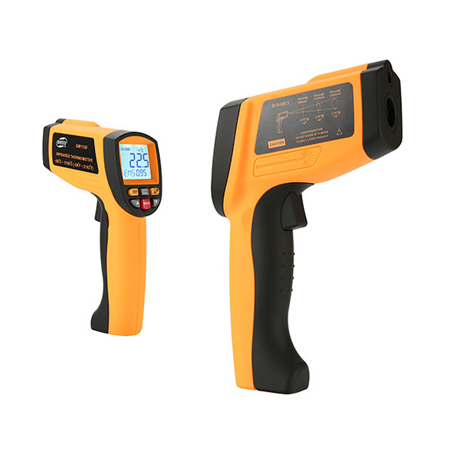How to Choose a Right Infrared Thermometer?
How to choose a right infrared thermometer? The first thing to think about is performance indicators, such as temperature range, spot size, working wavelength, measurement accuracy, response time, etc. Environmental and working conditions are also taken into account, such as ambient temperature, window, display and output, protection accessories, etc. Other factors, including convenience, maintenance and calibration performance and price, etc., also affect the selection of the infrared thermometer.
Temperature range
The temperature range is one of the most important performance indicators of the thermometer. For example, ATO products cover the range of -50 ℃ ~ + 1650 ℃, but this can not be done by a model of infrared thermometer. Each model of infrared thermometer has its own specific temperature range, such as -50℃ to +380℃, -50℃~1150℃ etc. Therefore, the user's measured temperature range must be considered accurate and comprehensive, neither too narrow nor too wide. According to the black body radiation law, the change of the radiant energy caused by the temperature in the short wavelength band of the spectrum will exceed the change of the radiant energy caused by the emissivity error. Therefore, it is better to select the short wave when measuring the temperature.
Target size
The infrared thermometer can be divided into a monochrome thermometer and a two-color thermometer (radiation colorimeter) according to the principle. For a monochrome thermometer, the measured target area should be filled with the field of view of the thermometer when measuring temperature. It is recommended that the measured target size exceeds 50% of the field of view size. If the target size is smaller than the field of view, it would cause error of the temperature reading. For a two-color thermometer, the temperature is determined by the ratio of the radiant energy in two independent wavelength bands. A two-color thermometer is a best choice under these conditions. The targets are small and are in motion or vibration; sometimes the targets are moving within the field of view, or possibly partially moving out of the field of view.
Optical resolution
The optical resolution is determined by the ratio of D to S (D refers to the distance between the infrared thermometer and the target; S refers to the measured spot diameter). If the infrared thermometer must be installed away from the target due to environmental limits, but to measure small targets, you should choose a high optical resolution thermometer. The higher the optical resolution, that is, the higher the D: S ratio, the higher the cost of the thermometer.
Wavelength range
The emissivity and surface characteristics of the target material determine the spectral response or wavelength of the infrared thermometer. In the high temperature zone, the optimum wavelength for measuring metallic materials is near-infrared, with a wavelength of 0.18-1.0 μm. Other temperature zones are available with 1.6μm, 2.2μm and 3.9μm wavelengths. Since some materials are transparent at a certain wavelength, infrared energy will penetrate these materials, and a particular wavelength should be chosen for this material. For example, the internal temperature of the measuring glass is selected to be 10 μm, 2.2 μm and 3.9 μm (the glass to be tested is very thick, otherwise it will pass through); the internal temperature of the measuring glass is selected to be 5.0 μm; the lower measuring area is preferably 8-14 μm.
Response time
The response time represents the response speed of the infrared thermometer to the measured temperature change. It is defined as the required time to 95% energy of reaching the final reading, which is related to the time constant of the photodetector, signal processing circuitry, and display system. The new infrared thermometer has a response time of up to 1ms. This is much faster than the contact temperature measurement method. If the target's motion speed is fast or when measuring a fast-heating target, a fast-response infrared thermometer should be chosen. Otherwise, sufficient signal response will not be achieved, which will reduce the measurement accuracy. However, not all applications require fast response infrared thermometers. For thermal inertia in stationary or target thermal processes, the requirement for the response time of the thermometer can be relaxed. Therefore, the response time of the infrared thermometer should be selected to match the situation of the target.
Signal processing function
In view of the fact that discrete processes (such as parts production) and continuous processes are different, infrared thermometers are required to have multiple signal processing functions (such as peak hold, valley hold, average). For example, when measuring temperature of bottles on a conveyor belt, peak value hold is needed, thus the output signal of its temperature is transmitted to the controller.
Environmental conditions
The environmental conditions have a great influence on the measurement results of infrared thermometer. Otherwise, it will affect the temperature measurement accuracy. When there are high-temperature, dust, smoke and steam, you can use the protective cover, water cooling, air cooling system, air purifier and other accessories to address environmental impacts and protect the thermometer for accurate temperature measurement. Fiber optic two-color thermometers are the best choice when reducing smoke, dust, or other particles in a noise, electromagnetic field, vibration, or inaccessible environment, or other harsh conditions. In the case of noise, electromagnetic fields, vibrations and inaccessible environmental conditions, or other harsh conditions, fiber optic colorimetric thermometers should be selected.

